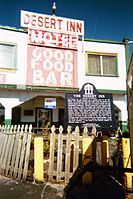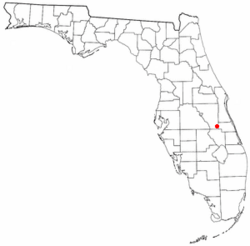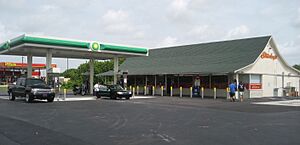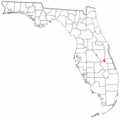Yeehaw Junction, Florida facts for kids
Quick facts for kids
Yeehaw Junction, Florida
|
|
|---|---|

Desert Inn
|
|

Location of Yeehaw Junction, Florida
|
|
| Country | |
| State | |
| County | |
| Area | |
| • Total | 1.88 sq mi (4.87 km2) |
| • Land | 1.87 sq mi (4.84 km2) |
| • Water | 0.01 sq mi (0.03 km2) |
| Elevation | 49 ft (15 m) |
| Population
(2020)
|
|
| • Total | 240 |
| • Density | 125.67/sq mi (48.52/km2) |
| Time zone | UTC−5 (Eastern (EST)) |
| • Summer (DST) | UTC−4 (EDT) |
| ZIP Code |
34972
|
| Area code(s) | 321 |
| FIPS code | 12-78975 |
| GNIS feature ID | 2403047 |
Yeehaw Junction is a small community in Osceola County, Florida, United States. It is called a census-designated place (CDP). This means it is an area that the government counts for population, but it is not an official town or city. In 2020, about 235 people lived there.
Yeehaw Junction is part of the larger Orlando–Kissimmee area. This is a big region where many people live and work. A new development called Destiny was also planned nearby.
Contents
Where is Yeehaw Junction?
Yeehaw Junction is located in Florida. It sits where several important roads meet. These roads include US 441, SR 60, and Florida's Turnpike. It is about 30 miles west of Vero Beach and 30 miles north of Lake Okeechobee.
The name "Yeehaw" comes from a train station that was once on the Florida East Coast Railway. This station was a few miles east of the current location.
The Story Behind the Name
There are a few ideas about how Yeehaw Junction got its name. Some people say locals used to shout "Yeehaw!" when they were excited. Others think the name comes from a Seminole language word that means "wolf."
According to old newspaper articles, the community was first called "Jackass Junction" or "Jackass Crossing." This name came about in the 1930s. Ranchers would ride their burros (small donkeys) to visit the local inn. In the 1950s, the Florida government decided to change the name. This happened when Florida's Turnpike was built through the area in 1957. That is how it became known as Yeehaw Junction.
People in Yeehaw Junction
| Historical population | |||
|---|---|---|---|
| Census | Pop. | %± | |
| 2010 | 240 | — | |
| 2020 | 235 | −2.1% | |
| U.S. Decennial Census | |||
In 2010, there were 240 people living in Yeehaw Junction. Most of the people were non-Hispanic white (89.2%). There were also small numbers of Native American, Asian, and people of two or more races. About 6.3% of the people were Hispanic or Latino. In 2020, the population was 235.
Yeehaw Junction Today
The exit for Yeehaw Junction on Florida's Turnpike is still used today. It used to be a popular stop for tourists. They would buy discount tickets for attractions in the Orlando area. However, that ticket booth is now closed.
The Turnpike exit connects to State Road 60. This road is important because it goes from Vero Beach on the Atlantic Ocean to Tampa and Clearwater Beach on the Gulf Coast. The Yeehaw Junction exit is special because it is the only exit for a long stretch of the Turnpike. It is at the start of the longest part of the highway without an exit in the U.S. The next exit north is almost 49 miles away. The next exit south is over 40 miles away.
Yeehaw Junction is a small community, so it does not have its own schools. Children can go to schools in the Osceola County School District. This might mean a long bus ride, sometimes over an hour. Students can also be bused to schools in nearby Indian River County or Okeechobee County.
The Desert Inn was a famous building in Yeehaw Junction. It closed for a while in 2018. There were plans to fix it up and reopen it as a museum, restaurant, and motel. However, in December 2019, a large truck crashed into the building. This caused a lot of damage. The owners are working to save what is left and hope to restore the site.
Images for kids
See also
 In Spanish: Yeehaw Junction para niños
In Spanish: Yeehaw Junction para niños





